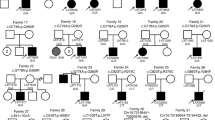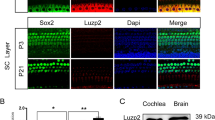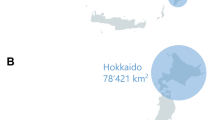Summary
In Sd/ + heterozygotes, tlie bodies of all the vertebrae are reduced. This includes the dens epistrophei -which is absent as a bony element though it is represented by a ligament. In the absence of this pivot for the turning movement of the head, an atypical but functional horseshoe-shaped articulation is established between atlas and epistropheus. Muscles normally inserting in the region of the atypical joint are shifted to a different position. The reduction of the vertebral bodies is due to a degeneration of the notochord which takes place when the vertebrae of the trunk region are still membranous. An hypothesis is put forward according to which the degeneration of the notochord is responsible not only for the reduction of the vertebral bodies, but also for the degeneration which leads to the loss of parts of the tail; this hypothesis requires the assumption that the notochord in these animals is physiologically defective about a day earlier than has so far been established by histological methods. The developmental connexion between urogenital anomalies and the rest of the syndrome remains obscure.
The research reported in this paper was supported by grants from the Medical Research Council and from the Rockefeller Foundation which are gratefully acknowledged. For the drawings of the plate, my thanks are due to Miss Pauhne Tarry.
Similar content being viewed by others
References
Carter, T. C. (1951). The genetics of luxate mice. I. Morphological abnormalities of heterozygotes and homozygotes.J. Genet.50, 277–99.
Dawes, B. (1930). The development of the vertebral column in mammals, as illustrated by its development inMus musculus.Philos. Trans. B,218, 115–70.
Dunn, L. C. (1942). Changes in the degree of dominance of factors affecting tail-length in the house mouse.Amer. Nat.76, 552–69.
Dunn, L. C. &Glueoksohn-Schoenheimer, S. (1945). Dominance modification and physiological effect of genes.Proc. Nat. Acad. Sci., Wash.,31, 82–4.
Dunn, L. C., Gluecksohn-Schoenheimer, S. &Bryson, V. (1940). A new mutation hi the mouse affecting spinal column and urogenital system.J. Hered.31, 343–8.
Fell, H. B. &Canti, R. G. (1934). Experiments on the developmentin vitro of the avian knee joint.Proc. Roy. Soc. B,116, 316–51.
Fisher, R. A. &Holt, S. B. (1944). The experimental modification of dominance in Danforth’s short-tailed mutant mice.Ann. Eugen., Land.,12, 102–20.
Gluecksohn-Schoenheimer, S. (1943). The morphological manifestations of a dominant mutation in mice affecting tail and urogenital system.Genetics,28, 341–8.
Gluecksohn-Schoenheimer, S. (1945). The embryonic development of mutants of the Sd-strain in mice.Genetics,30, 29–38.
Grüneberg, H. (1938). An analysis of the ‘pleiotropic’ effects of a new lethal mutation hi the rat (Mus norvegicus).Proc. Roy. Soc. B,125, 123–44.
Grüneberg, H. (1947). Bilateral defect of the radius in a mouse.Acta Anatomica,2, 270–4.
Grüneberg, H. (1950). Genetical studies on the skeleton of the mouse. II. Undulated and its ‘modifiers’.J. Genet.50, 142–73.
Hörstadius, S. (1944). Über die Folgen von Chordaexstirpation an späten Gastrulae und Neurulae vonAmbystoma -punctatum.Acta Zool.25, 75–87.
Kitchin, I. C. (1949). The effects of notochordectomy inAmblystoma mexicanum.J. Exp. Zool.112, 393–115.
Lehmann, F. E. &Ris, H. (1938). Weitere Untersuchungen über die Entwicklung der Achsenorgane bei partiell chordalosen Tritonlarven.Rev. Suisse Zool.45, 419–23.
Murray, P. D. F. (1936).Bones. A Study of the Development and Structure of the Vertebrate Skeleton. Pp. x + 203. Cambridge University Press.
Theiler, K. (1950). Die Auswirkung von partiellen Chordadefekten beiTriton alpestris. Beitrag zur Entwicklumgsmechanik der Wirbelsäule.Roux Arch. EntwMech. Organ.144, 476–90.
Theiler, K. (1951). Die Entwicklung der Zwischenwirbelscheiben bei der Short-Danforth-Maus.Rev. Suisse Zool.58, 484–8.
Author information
Authors and Affiliations
Rights and permissions
About this article
Cite this article
Grüneberg, H. Genetioal studies on the skeleton of the mouse. Journ. of Genetics 51, 317–326 (1953). https://doi.org/10.1007/BF03023300
Issue Date:
DOI: https://doi.org/10.1007/BF03023300




